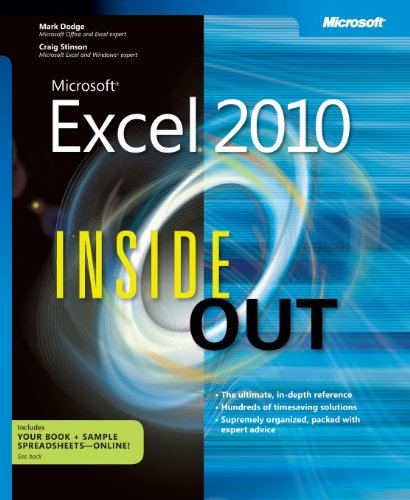Articoli correlati a Microsoft Excel 2010 Inside Out

Sinossi
You're beyond the basics, so dive in and really put your spreadsheet skills to work! This supremely organized reference is packed with hundreds of timesaving solutions, troubleshooting tips, and workarounds. It's all muscle and no fluff. Discover how the experts tackle Excel 2010-and challenge yourself to new levels of mastery!
- Learn expert techniques for designing powerful spreadsheets
- Apply built-in functions-or write your own-and carry out complex calculations
- Use rich charting and graphic capabilities to visualize data
- Perform sophisticated data analysis: financial, statistical, and "what-if"
- Design PivotTable reports to dynamically analyze data
- Share and collaborate with others-while managing sensitive data
- Link and embed Excel data into other documents
- Create macros with Microsoft Visual Basic for Applications
Le informazioni nella sezione "Riassunto" possono far riferimento a edizioni diverse di questo titolo.
Informazioni sugli autori
Craig Stinson is a computer journalist and author. He has written or coauthored more than 20 books, including Microsoft Windows XP Inside Out, Deluxe Edition.
Craig Stinson is a computer journalist and author. He has written or coauthored more than 20 books, including Microsoft Windows XP Inside Out, Deluxe Edition.
Le informazioni nella sezione "Su questo libro" possono far riferimento a edizioni diverse di questo titolo.
EUR 14,93 per la spedizione da U.S.A. a Italia
Destinazione, tempi e costiRisultati della ricerca per Microsoft Excel 2010 Inside Out
Microsoft Excel 2010 Inside Out
Da: Bookmonger.Ltd, HILLSIDE, NJ, U.S.A.
paperback. Condizione: Good. Crease on cover and a few pages*. Codice articolo mon0000694616
Quantità: 1 disponibili
Microsoft® Excel® 2010 Inside Out
Da: AwesomeBooks, Wallingford, Regno Unito
Paperback. Condizione: Very Good. Microsoft® Excel® 2010 Inside Out This book is in very good condition and will be shipped within 24 hours of ordering. The cover may have some limited signs of wear but the pages are clean, intact and the spine remains undamaged. This book has clearly been well maintained and looked after thus far. Money back guarantee if you are not satisfied. See all our books here, order more than 1 book and get discounted shipping. . Codice articolo 7719-9780735626881
Quantità: 1 disponibili
Microsoft® Excel® 2010 Inside Out
Da: Bahamut Media, Reading, Regno Unito
Paperback. Condizione: Very Good. Shipped within 24 hours from our UK warehouse. Clean, undamaged book with no damage to pages and minimal wear to the cover. Spine still tight, in very good condition. Remember if you are not happy, you are covered by our 100% money back guarantee. Codice articolo 6545-9780735626881
Quantità: 1 disponibili
Microsoft Excel 2010 Inside Out
Da: WorldofBooks, Goring-By-Sea, WS, Regno Unito
Paperback. Condizione: Very Good. The book has been read, but is in excellent condition. Pages are intact and not marred by notes or highlighting. The spine remains undamaged. Codice articolo GOR004038125
Quantità: 2 disponibili
Microsoft® Excel® 2010
Da: Better World Books, Mishawaka, IN, U.S.A.
Condizione: Good. 1st Edition. Former library book; may include library markings. Used book that is in clean, average condition without any missing pages. Codice articolo 10461540-6
Quantità: 2 disponibili
Microsoft® Excel® 2010
Da: Better World Books: West, Reno, NV, U.S.A.
Condizione: Very Good. 1st Edition. Used book that is in excellent condition. May show signs of wear or have minor defects. Codice articolo 7458251-6
Quantità: 1 disponibili
Microsoft Excel 2010 Inside Out
Da: Persephone's Books, Gastonia, NC, U.S.A.
Trade Paperback. Condizione: Very Good. No Jacket. xxviii, 1122 pp. The lightest of rubbing to the cover edges. The binding is tight and square, and the text is clean. Codice articolo 071177
Quantità: 1 disponibili
Microsoft Excel 2010 Inside Out
Da: ThriftBooks-Dallas, Dallas, TX, U.S.A.
Paperback. Condizione: Good. No Jacket. Pages can have notes/highlighting. Spine may show signs of wear. ~ ThriftBooks: Read More, Spend Less 3.75. Codice articolo G073562688XI3N00
Quantità: 1 disponibili
Microsoft Excel 2010 Inside Out
Da: ThriftBooks-Atlanta, AUSTELL, GA, U.S.A.
Paperback. Condizione: Very Good. No Jacket. May have limited writing in cover pages. Pages are unmarked. ~ ThriftBooks: Read More, Spend Less 3.75. Codice articolo G073562688XI4N00
Quantità: 1 disponibili
Microsoft? Excel? 2010 Inside Out
Da: SecondSale, Montgomery, IL, U.S.A.
Condizione: Good. Item in good condition. Textbooks may not include supplemental items i.e. CDs, access codes etc. Codice articolo 00071934684
Quantità: 2 disponibili

